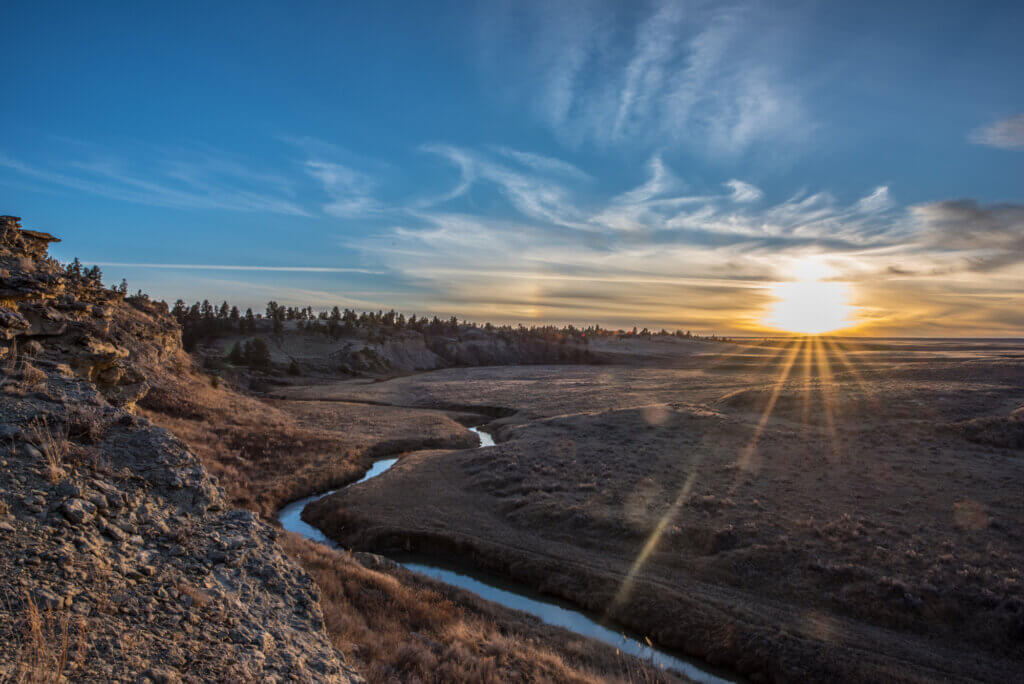Coulee Country
By Heather Bilden
Broadcast 7.19 & 7.22.2023

Coulee Creek. Photo © Alexis Bonogofsky.
Listen:
Hiking across the expanse of central Montana prairie that I call home, I can see at least three mountain ranges in the distance at all times. On the horizon to the north are the Snowy Mountains, a low range blanketed in white that holds fond memories of summertime retreats from the heat of the high plains. To the west are the Crazies, jagged and powerful, the epitome of majestic mountains. Far to the south the Beartooth front appears diminutive, although I know from experience the true heft of their uplift from the Yellowstone Valley far below. And to the east, the forested ridges of the Bull Mountains loom close and familiar. In comparison with these formidable landforms, the rolling prairie may seem uninspiring and monotonous. But I know that this prairie holds a secret. This is coulee country, a landscape peppered with gullies waiting to be explored.
When I moved to the banks of Big Coulee Creek, I didn’t realize the significance of this name. I had become accustomed to it through my growing familiarity with my husband’s nearby hometown of Lavina and had to chuckle when my sister sent me an NPR article titled “Do We Talk Funny? 51 American Colloquialisms.” According to the author, the main regionalism heard across Montana is – you guessed it – coulee. Turns out this isn’t just the name of the creek where we live, but it is a name applied more broadly across the region to these distinct features of the landscape, the steep-sided valleys carved by intermittent flowing water. It derives from the French verb “couler,” to flow. Before moving here, I had heard of ravines, draws, and gulches, but I was unfamiliar with coulees. Now I found myself surrounded by them: Pine Coulee, Twin Coulee, and Sand Coulee, to name a few.
The creek that runs by our home starts in the Big Coulee twenty-five miles southwest of us. My favorite hiking path takes me across the prairie to the edge of the cliffs above Big Coulee Creek. Here the prairie was never disturbed by farming and a diverse suite of native grasses thrives: three awn, bluebunch wheatgrass, blue grama, and my personal favorite, Indian ricegrass, whose open panicles wave in the breeze like tiny chandeliers. I descend into a small coulee that will thread me down to the creek bottom and I immediately feel a drop in temperature. Here I enter a microclimate where the moisture is great enough for the ponderosa pines, which grow short and stocky on the rims above, to become towering trees more typical of the forests in the wetter western part of Montana.
The edges of the coulee around me are rimmed with sandstone slabs jutting out in angular shapes of various sizes and in various states of decay. Occasionally I’ve grabbed a piece of rock and looked down to find the imprint of a bivalve shell, remnants of life from an inland ocean that covered much of the interior of North America. Underneath the sandstone ledges, piles of animal scat have accumulated over the years. Residents that take shelter here include the bushy-tailed woodrat and the porcupine, who makes its dens in the bigger cave-like crevices. Where the coulee opens up above the shores of the creek, swallow nests dot the cliffs and one large pile of sticks marks the nest site of a hawk high on a sheltered ledge.
Coulee country is indeed home to many discoveries if you slow down to listen to the whispers of the secrets held in this landscape. Treasures await in the cool, protected depths of these coulees etched into the prairie across Montana.
Every week since 1991, Field Notes has inquired about Montana’s natural history. Field Notes are written by naturalists, students, and listeners about the puzzle-tree bark, eagle talons, woolly aphids, and giant puffballs of Western, Central and Southwestern Montana and aired weekly on Montana Public Radio.
Click here to read and listen to more Field Notes. Field Notes is available as a podcast! Subscribe on Apple Podcasts or wherever you listen to podcasts.
Interested in writing a Field Note? Contact Allison De Jong, Field Notes editor, at adejong [at] montananaturalist [dot] org or 406.327.0405.
Want to learn more about our programs as well as fun natural history facts and seasonal phenology? Sign up for our e-newsletter! You can also become a member and get discounts on our programs as well as free reciprocal admission to 300+ science centers in North America!












